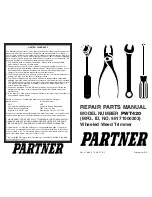
12
3. Rest the unit on a flat, firm area. Keep the cutting
head off the ground and clear of surrounding objects,
as it will start rotating upon engine starting.
4. When Cold Starting, move the choke lever to the
closed position. (Image on Pg.11)
(1) Choke lever
(2) Close
(3) Open
5. If the engine has been running and is still warm,
move the choke lever to the open position.
6. Press the priming bulb under the
carburettor repeatedly until excess fuel can be seen
returning to the tank through the clear fuel return
pipe.
7. Slide the ignition switch (2) on the trigger grip
away from the STOP position
8. To set the throttle in the start position.
- Depress the safety lever (4) and squeeze the
throttle lever (1) fully. Hold down the starting button
(3). Releasing the throttle lever and then the starting
button.
- The throttle lever will be held partly open until it is
squeezed again.
(1) Throttle lever
(2) Ignition Switch
(3) Starting button.
(4) Safety Lever
9. While holding the unit firmly, pull out the starter
rope quickly.
10. After the engine has started, open the
choke gradually.
11. Allow the engine to run for 2 to 3 minutes to
warm up before starting work.
NOTE
OVERCHOKING
• Should the engine become flooded due to
over-choking set the ignition switch to the STOP (2),
unscrew the spark plug, wipe it dry or replace, pull
the recoil starter several times without the spark plug
in place and with the choke set to the open position.
This will help clean and ventilate the combustion
chamber.
8.2 STOPPING THE ENGINE
• Set the engine to idling by releasing the throttle
lever.
• Set the ignition switch to the STOP (2) position.
• If the engine fails to stop, set the choke lever to the
closed position to stall the engine; do not use the
machine until the ignition switch is repaired.
RUNNING IN
• During the first ten hours of work, avoid running the
engine at maximum speed for a prolonged period
until all the components have bedded in. After the
engine has been run-in, it will reach its maxi-
mum power.
WARNING
DO NOT breath in engine exhausts as it is identified
as a health risk and contains chemicals known to
(1)
(3)
(2)
(4)


































